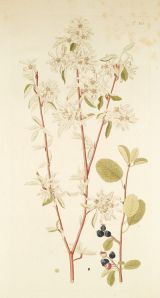Forward Juneberry
By Audrey Stallsmith

Now that the bright red berries lend
color to the Juneberry tree
my need is urgent to befriend
denial and austerity.
I touch the fruits with lips of wish
and with the fingers of soft words,
and leave them, a delicious dish
in taste and substance to the birds.
Jessica Powers--"Richer Berry"
We always look for Juneberries in April. They are easy to spot then, a flurry of white blossoms against the still naked branches of the other trees.
In earlier times, people watched for those flowers even more eagerly than we do. The pristine petals usually meant the ground had thawed enough to allow burial services for loved ones who had died over the winter. That supposedly led to the Juneberry also being known as serviceberry.
Some people hold that name actually comes from the berries' resemblance to another fruit, "service" being a corruption of sorbus--AKA "service tree." But the funeral idea seems considerably more colorful. Or, perhaps I should say, colorless!
Juneberry is also known as shadbush, shadwood, or shadblow because that fish migrates upstream to spawn during its bloom time. The official title amelanchier derives from the French name for the tree.
Juneberry's blossoms appear somewhat similar to those on apple trees, and its fruits--which ripen in late June or early July--look something like wild blueberries. But they are red first, and edible in either color, with the seeds tasting like almonds.
James Duke, in his Handbook of Edible Weeds, describes the flavor as varying between "the drier rose hips and the wetter plums." You will have to beat the birds to them, though! That may be just as well since Duke also cautions that "the pits and stones,. . .contain cyanide-like compounds" and "in large quantities. . .could cause cyanide poisoning."
In Native American Women's Writing, Buffalo Bird Woman says of Juneberry that "we called the tree itself mida kati, real tree, genuine tree, because we thought the wood the best of the forest. . .we used it in making wooden pins to stake our green hides to dry, and for tent pins. It was the usual wood for making arrow shafts, being tough and unyielding. . ."
The Bird Woman reports that the berries differed in sweetness, size, and color from tree to tree, and that some of them were even white. They also came in handy for allowing a young brave to express his romantic intentions. "A young man might send word to his sweetheart by some female relative of his own saying, 'That young man says that when you want to go for Juneberries, he wants to go along with you!' Or else he watched when she came out of the lodge to start berrying; for it was not our custom for a young man to talk openly with a young woman."
A concoction made from Juneberry bark has been used to curb excessive menstrual bleeding and diarrhea, and to prevent miscarriage--as well as to expel worms. But the biggest attraction is still the berries--especially to birds.
In an old agricultural bulletin published by Cornell University in 1891, L. H. Bailey writes that "there is one serious difficulty in the cultivation of this fruit [a dwarf form of Juneberry]. . .which we have not been able to overcome--the incursions of the robins. There is no fruit on our plantations which is so irresistible to the birds as this, and nothing short of actual shooting will keep them away."
Some people plant this tree as an ornamental, just for the fun of seeing feathered friends flock to the fruit. (Try saying that three times fast!) And the scarlet orange leaves in the fall are just an added bonus. But Juneberry will probably always be best loved for the boldness of its early bloom--a flurry of flowers instead of snowflakes.
Amelanchier rotundifolia image is from Florae Austriacae by Nicolai Josephi Jacquin courtesy of the Missouri Botanical Garden.








